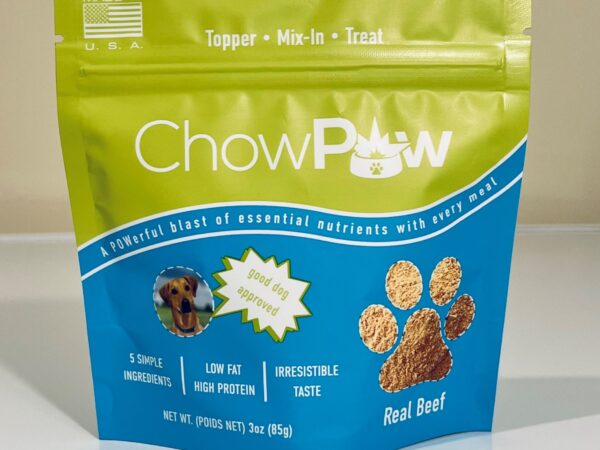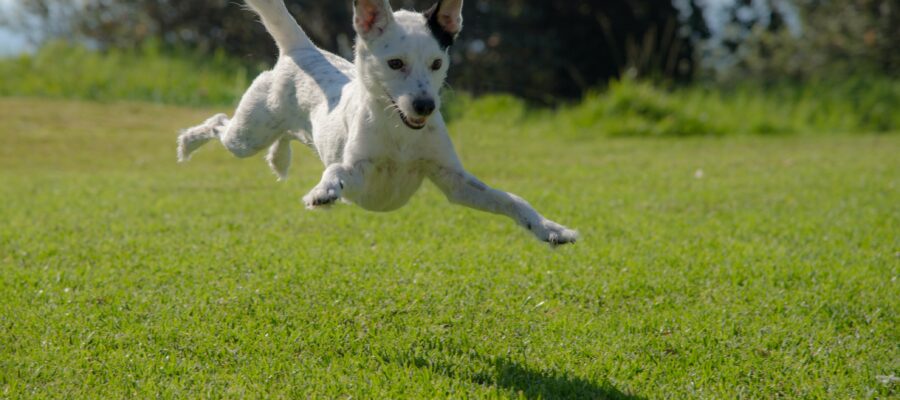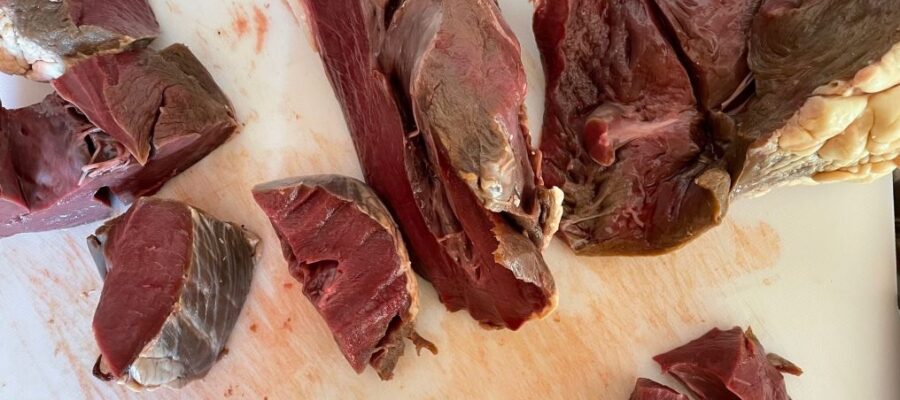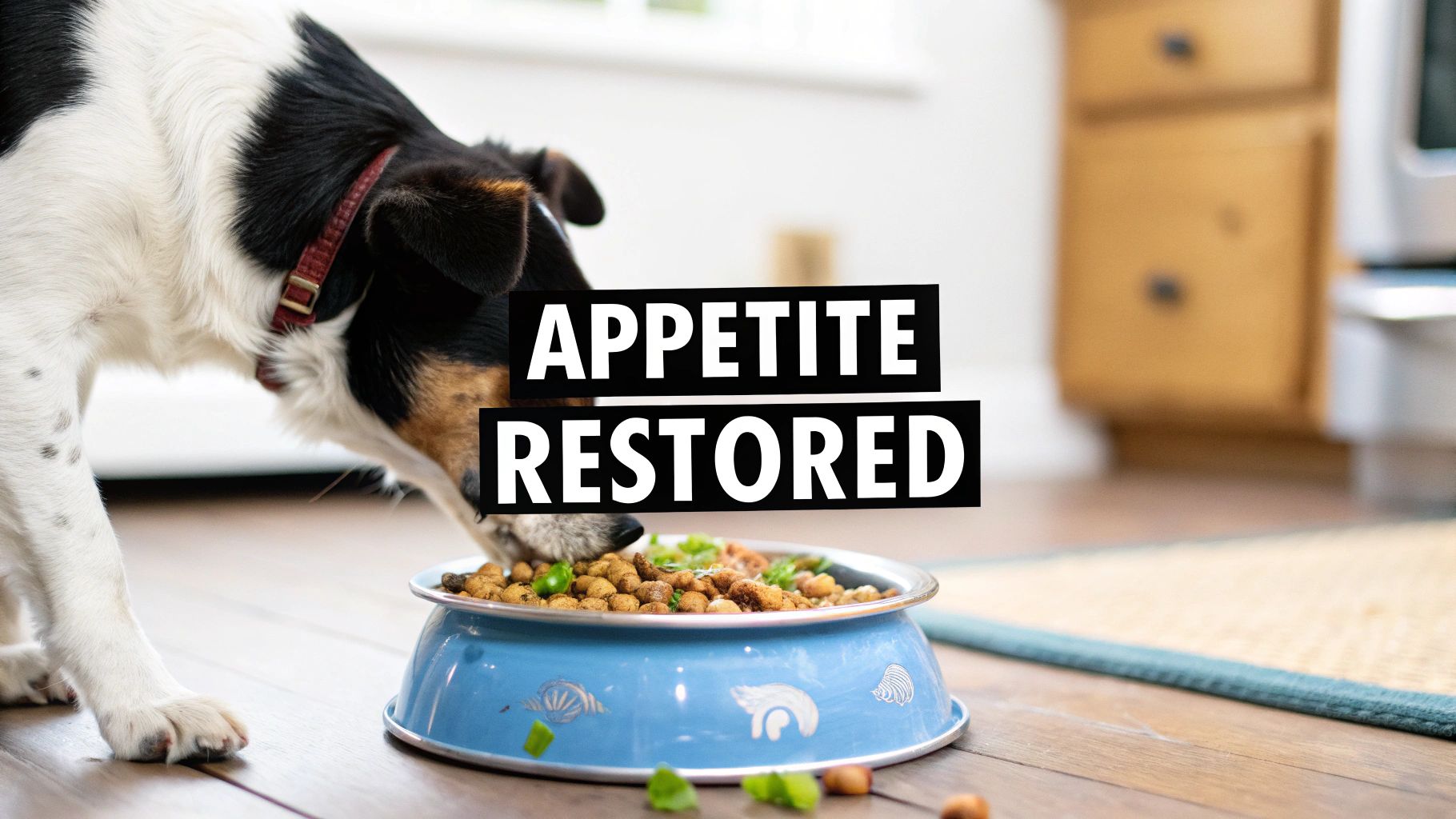
Dog Won’t Eat Dry Food? Top Causes & Effective Solutions
It’s a stressful moment for any dog owner: you put down the bowl of kibble, just like every other day, and your dog just… doesn’t eat. Especially when it happens out of the blue.
The simple truth is that this behavior is often a sign of something else going on. It could be anything from a painful tooth to simple boredom with their daily meal. Figuring out the “why” is the first real step to finding a solution and getting them excited about their food again.
Decoding Your Dog’s Kibble Strike
When a dog who normally cleans their bowl suddenly turns up their nose, it’s a clear signal that something is off. This abrupt change can be alarming, but before you panic, it helps to run through a mental checklist of possible reasons.
The reasons a dog refuses kibble usually fall into one of three categories: medical issues, behavioral quirks, or problems with the food itself.
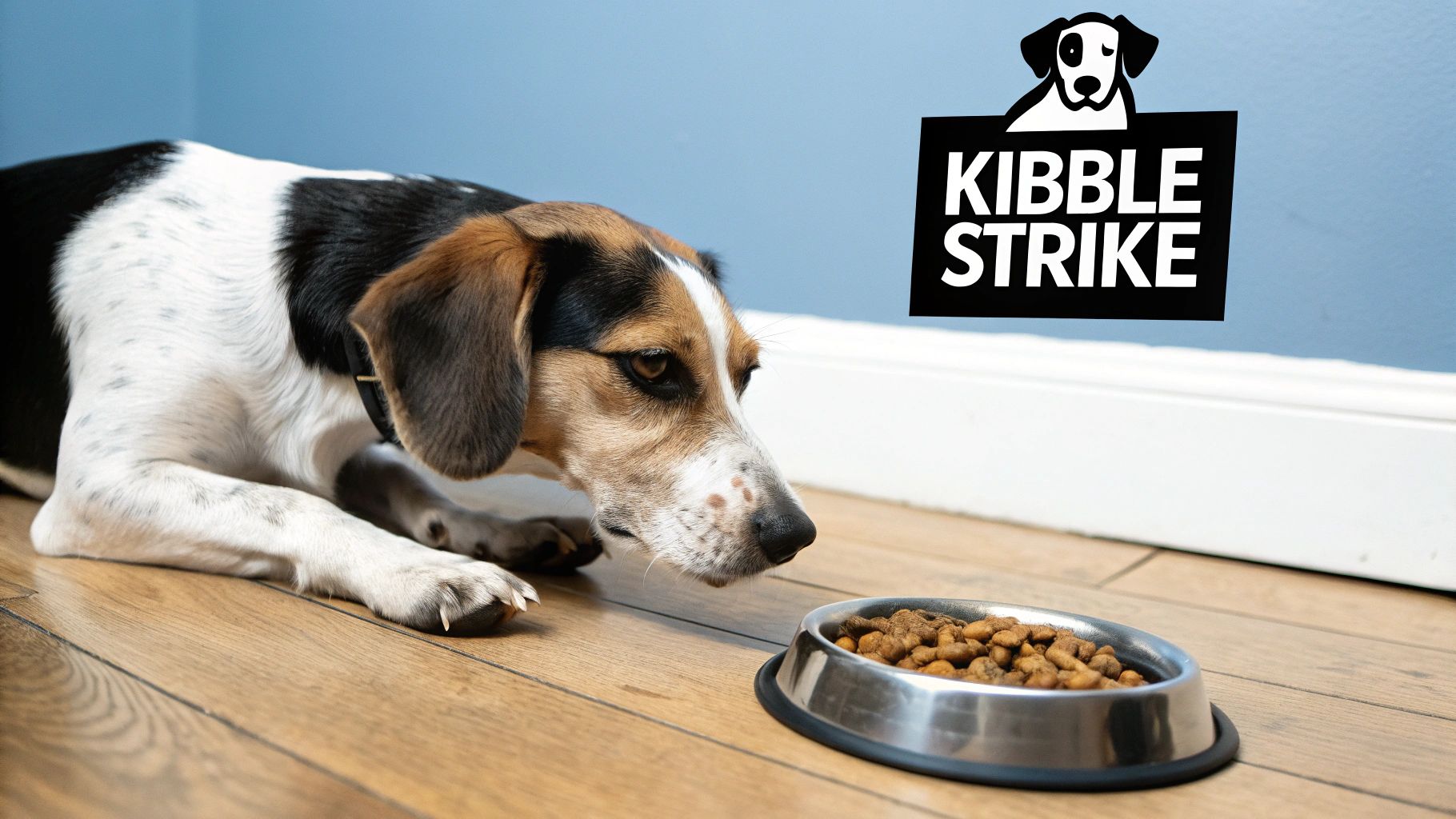
Trust us, you’re not alone in this. Vets regularly see dogs for this exact issue. The most common culprits? Dental issues, underlying health problems, or just plain food fatigue.
Common Reasons Your Dog Refuses Dry Food
Let’s break down the most frequent reasons behind a kibble strike. By watching your dog’s other behaviors, you can often pick up clues that point you in the right direction. To help you connect the dots, here’s a quick-glance table comparing the signs of each potential issue.
| Potential Cause | Common Signs to Look For | First Action to Take |
|---|---|---|
| Dental Pain | Dropping food, chewing on one side, bad breath, reluctance to be touched near the mouth. | Schedule a veterinary check-up immediately. |
| Food Boredom | Shows interest in treats or human food but ignores kibble. Energy levels are normal. | Try making the food more appealing with a topper or by adding warm water. |
| Behavioral Pickiness | Watches you expectantly after refusing food, eagerly accepts “better” options. | Stop offering table scraps and stick to a consistent feeding routine. |
| Stale or Bad Kibble | Sniffs the food and walks away. Check the bag for an expiration date or off-smells. | Store kibble in an airtight container and consider buying a fresh, smaller bag. |
This framework gives you a solid starting point for your investigation. For instance, a dog with a sore mouth needs a vet visit, not a new food flavor. On the other hand, a dog suffering from “kibble fatigue” might just need a simple meal enhancement to get them interested again.
Key Takeaway: A dog refusing to eat is communicating something important. Pay close attention to whether they are showing signs of pain, acting otherwise normal, or just seem uninterested in their food.
Understanding these different possibilities is crucial. By methodically considering each one, you can move from a place of worry to one of empowered action, ready to find the right solution to get your dog happily eating again.
For a deeper dive into this behavior, you can learn more about why dogs become picky eaters and how to help them in our detailed guide.
When Should You Call the Vet About Appetite Loss?
It’s tempting to brush it off when your dog suddenly turns their nose up at their kibble. We’ve heard it countless times from fellow dog owners: “He’s just being picky,” or “She must be bored with her food.” And sometimes, that’s true. But a sudden change in appetite is one of the clearest ways your dog can tell you something is wrong.
Before you start swapping out food brands or searching for the perfect meal topper, your first move should always be to rule out a medical issue. A loss of appetite, which vets call anorexia, is a very general symptom that can point to all sorts of health problems. Ignoring it might mean delaying important treatment. Your vet is the only one who can truly tell you if the problem is behavioral or medical.
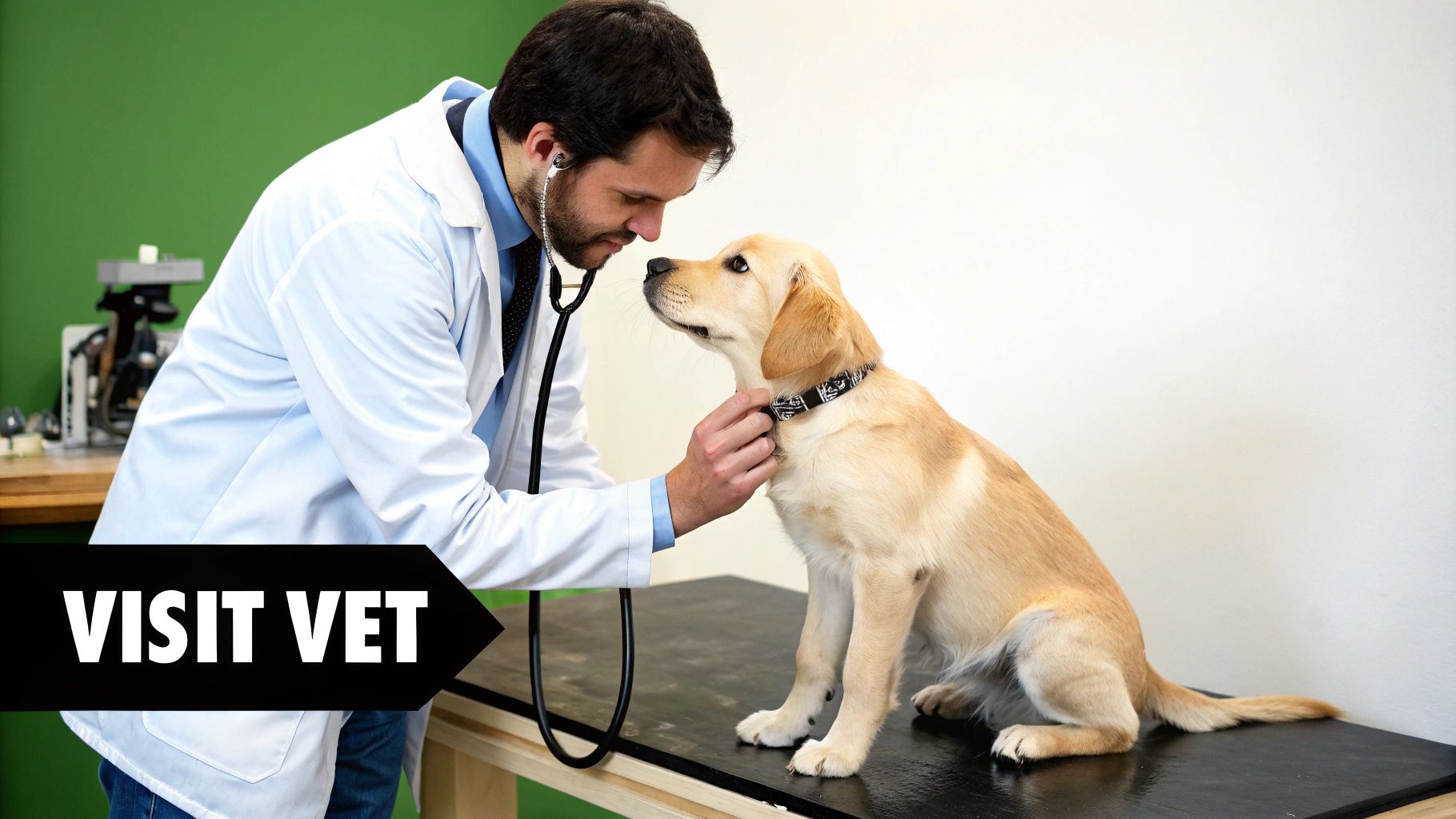
Uncovering Hidden Health Issues
Many illnesses creep in with subtle signs, and refusing to eat is a big one. It’s often not about the taste of the food at all, but about the discomfort that comes with eating it.
A friend of ours just went through this with her Beagle, Cooper. He abruptly started leaving his kibble untouched but would happily gobble up soft treats. After a few days of this, she finally took him to the vet, thinking he was just being stubborn. It turned out he had a painful cracked molar way in the back of his mouth where she couldn’t see it. Chewing hard kibble was agony for him. Once the tooth was taken care of, he was back to his old self, crunching away happily.
Cooper’s story is incredibly common. Other hidden problems can make a dog stop eating dry food, including:
- Gastrointestinal (GI) Problems: Things like pancreatitis, gastritis, or even something stuck in their intestines can cause serious nausea and pain, making food the last thing on their mind.
- Systemic Illness: More serious conditions like kidney disease, liver issues, or even some cancers can lead to a drop in appetite.
- Infections: Just like us, when a dog is fighting off an infection or virus, they often don’t feel like eating.
How to Prepare for Your Vet Visit
To get the most out of your appointment, you need to go in with more than just, “My dog won’t eat.” The more details you can give your vet, the quicker they can pinpoint the problem.
Try to be a detective for a day or two before you go. Jotting down notes can help you remember everything when you’re talking to the vet.
Vet Visit Checklist:
Keep a running log of these observations to share with your veterinarian:
- Energy Levels: Is your dog sleeping more or seem less interested in walks and playtime?
- Drinking Habits: Have you noticed them drinking way more or less water than usual?
- Bathroom Routine: Any signs of diarrhea, constipation, or changes in how often they’re urinating?
- Physical Symptoms: Have you seen any vomiting, excessive drooling, or whimpering?
It’s Not Just Your Dog: The Trend Away From Kibble
If you’re going through this, you’re not alone. More and more dog owners are finding themselves in the same boat. In fact, many dog owners start looking for alternatives to standard kibble within their pet’s first year, usually because their dog won’t eat it or has digestive issues.
This growing trend really drives home a key point: while some dogs are just finicky, a lot of them might be reacting to an underlying health issue that makes eating hard kibble uncomfortable. A quick trip to the vet gives you peace of mind and ensures you’re treating the real cause, not just the symptom. Once you get the all-clear, you can start having fun finding ways to make mealtimes exciting again.
Making Your Dog’s Kibble Irresistible
Okay, so you’ve gotten the all-clear from your vet. That’s a huge relief! Now you can switch from worrying to taking action. The mission is simple: transform that boring bowl of brown biscuits into a meal your dog actually gets excited about. This is where you get to play chef, using scent, texture, and flavor to win back your pup’s appetite.
If you’re in this boat, you’re far from alone. It’s so common, in fact, that many dog owners have tried alternatives like wet, raw, or home-cooked meals. You can see just how widespread this issue is by digging into the latest trends in the pet food market.
But before you consider a complete dietary overhaul, let’s try a few simple tricks. Sometimes, a small enhancement can make a world of difference.
Tapping Into Your Dog’s Senses
A dog’s world revolves around their nose. Their sense of smell is incredibly powerful, and it plays a massive role in their appetite. Let’s be honest—dry kibble, especially if the bag has been open for a while, doesn’t smell like much of anything. Your first job is to change that.
One of the easiest wins is to add a splash of warm liquid. The warmth helps release the aromas trapped inside the kibble, making the whole bowl smell way more appealing.
Here are a few simple, vet-approved options to try:
- Warm, Low-Sodium Bone Broth: This is our go-to. It adds a rich, meaty aroma that most dogs can’t resist. Plus, it’s a great way to sneak in some extra hydration.
- Warm Water: Yep, even plain old warm water can work wonders. It softens the kibble and creates a more fragrant, stew-like consistency that many dogs prefer.
- A Spoonful of Wet Food: Mixing in a small amount of high-quality wet food is a great way to introduce new textures and a much stronger scent, encouraging your dog to finally dig in.
Pro Tip: After adding any liquid, let the bowl sit for a few minutes. This gives the kibble time to absorb the moisture and soften up, which is a big help for senior dogs or pups with sensitive teeth.
Boosting Flavor and Nutrition Naturally
Beyond just making the food smell better, you can add simple ingredients that boost both the flavor and the nutritional value. The key here is moderation. These are just little extras to avoid upsetting your dog’s stomach.
Think of them as healthy “seasonings” for their main course. You aren’t replacing the core nutrition of the kibble; you’re just making it more exciting.
Simple and Safe Kibble Mix-Ins
- Plain Pumpkin Purée: A spoonful of 100% pure pumpkin purée (make sure it’s not the pie filling!) adds a touch of sweetness and a fantastic source of fiber, which is a huge plus for digestive health.
- Plain, Cooked Eggs: A scrambled or hard-boiled egg is an excellent source of protein. Just remember—no salt, butter, or seasonings. Keep it simple.
- Sardines in Water: For a major boost of omega-3 fatty acids, mash up one or two sardines packed in water (no salt added, of course) and mix it in. The strong smell is a huge draw for most dogs.
These small additions can completely reignite your dog’s interest in mealtime. They prove that your dog is willing to eat—they just needed a little nudge. This success is the perfect stepping stone to finding a more permanent, convenient solution, like a high-quality meal enhancer designed specifically to solve this exact problem.
Transform Mealtime with a Nutrient-Rich Topper
So you’ve tried the home remedies. You’ve drizzled broth, spooned in some pumpkin, maybe even mixed in a little wet food. And for a little while, it worked! But now you’re back to square one, with your dog giving you that same old look.
Those quick fixes are great in a pinch, but they aren’t always a consistent, nutritionally balanced solution. This is where a high-quality meal topper like ChowPow really becomes a game-changer. It’s a real, lasting solution designed to make any kibble irresistible.
We created ChowPow to solve this exact problem. It’s not just about adding flavor; it’s a simple, whole-food formula designed to appeal directly to your dog’s most powerful sense—their nose. By seriously boosting the aroma of their existing kibble, it flips that instinctual feeding switch and turns a boring meal into something they’re actually excited to eat.
What Makes ChowPow Different
When your dog turns their nose up at dry food, the answer isn’t just masking the taste. It’s about adding real, wholesome nutrition that also happens to be irresistible. We made ChowPow with just four simple, human-grade ingredients you can actually recognize and understand: dehydrated beef heart, carrots, celery, and a touch of apple cider vinegar.
- Beef Heart: This is the star of the show. It’s a nutrient-dense organ meat, packed with high-quality protein and essential amino acids that support muscle health and energy. The incredible aroma is what gets picky dogs excited.
- Carrots and Celery: These add a hint of natural sweetness, a bit of fiber for healthy digestion, and a boost of essential vitamins.
- Apple Cider Vinegar: Just a small amount helps support a healthy gut microbiome, which is a cornerstone of overall wellness.
There are absolutely no fillers, no artificial flavors, and no mystery powders. You’re giving your dog a concentrated boost of real food, which is precisely why it works so well. The dehydration process locks in the nutrients and creates an incredible aroma that even the pickiest dogs find hard to resist.
If you’re curious about what else is out there, it can be helpful to explore some of the best dog food toppers for picky eaters to see how different options compare.
How to Introduce ChowPow to Your Dog
Getting started with ChowPow is incredibly simple. You don’t have to change your dog’s food; you just make it better.
Just sprinkle a small amount—about half a teaspoon for a small dog or a full teaspoon for a larger one—over their regular kibble. You can serve it as a dry powder, or you can add a little warm water and stir it up to create a rich, savory gravy that coats every single piece. The gravy method is a favorite, as the warmth really brings out that meaty aroma.
Our Tip: For the first few meals, we recommend mixing the ChowPow in thoroughly. This encourages your dog to eat their entire meal to get all that delicious flavor, rather than just licking the powder off the top.
This infographic shows exactly what a difference ChowPow can make to a standard bowl of kibble.
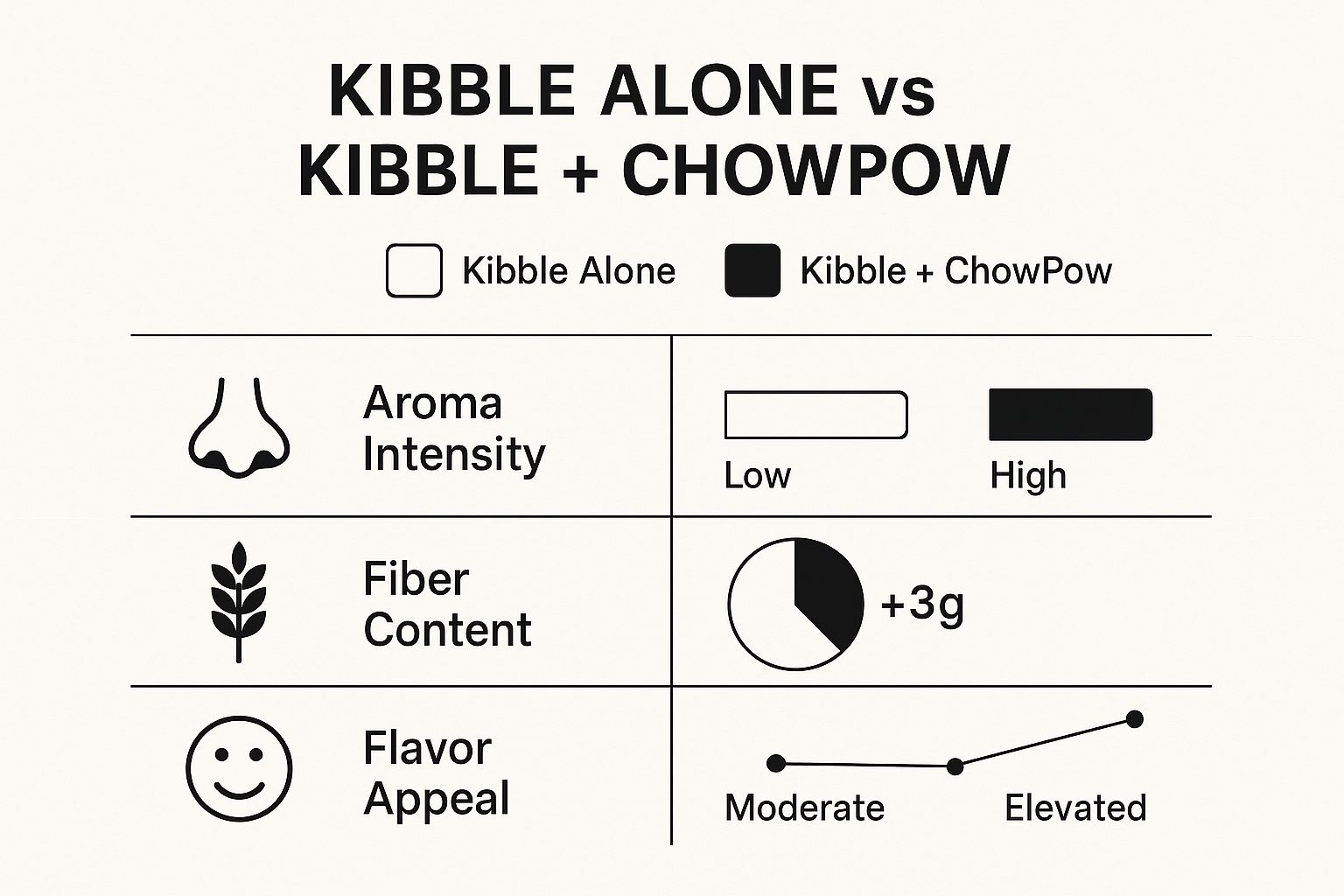
As you can see, it’s not just about adding flavor. It’s about elevating the entire sensory experience, turning a bland meal into a multi-faceted feast.
How ChowPow Compares to Other Solutions
When you’re trying to entice a picky eater, you’ve got a few options. Here’s a quick look at why a dedicated meal enhancer like ChowPow is the most effective and convenient way to solve the picky eater problem for good.
| Solution | Effectiveness for Picky Eaters | Nutritional Benefit | Convenience |
|---|---|---|---|
| ChowPow Topper | High. Formulated to boost aroma and flavor. Consistent results. | High. Adds protein, vitamins, and fiber from whole-food ingredients. | Very High. Just scoop and sprinkle. No prep or refrigeration needed. |
| Wet Food | Medium to High. Often very palatable, but can lead to dogs picking it out. | Varies greatly by brand. Can add unnecessary fats and calories. | High, but requires storing open cans in the fridge. Can be messy. |
| Broth/Water | Low to Medium. Can temporarily increase interest, but the effect often wears off. | Low. Mostly adds moisture and sodium without significant nutrients. | Medium. Requires having broth on hand or warming up water. |
| Human Food (e.g., chicken) | High. Very appealing, but can encourage begging and food refusal without it. | Can be unbalanced and may lack key canine nutrients. | Low. Requires cooking, storing, and portioning separately. |
While other methods can work in a pinch, a well-formulated topper like ChowPow provides a balanced, reliable, and convenient way to end mealtime battles without compromising nutrition.
More Than Just a Topper
ChowPow’s fine, powder-like consistency makes it incredibly versatile. It’s not just a fix for a picky eater; it’s a multi-purpose tool for smart dog owners.
- Hydration Helper: On hot days or for dogs who just don’t drink enough, mix a spoonful into a bowl of water. It creates a tasty “broth” that encourages them to hydrate.
- Medication Disguise: We all know the struggle of hiding pills. A little ChowPow mixed with a splash of water forms a paste that can easily conceal medication. The strong beefy smell masks any medicinal scent, making pill time so much easier.
- Support for Seniors & Recovering Dogs: For older dogs with sensitive teeth, creating a soft, gravy-like meal is a huge help. It’s also perfect for dogs recovering from an illness or surgery whose appetites might be low but who need top-notch nutrition to get back on their paws.
Ultimately, ChowPow gives you confidence. You know exactly what’s in it, you can see how well it works, and you can finally put an end to the frustrating mealtime standoff. It’s about empowering you to keep feeding the kibble your vet recommends while making sure your dog actually loves every single bite.
Building a Positive and Consistent Feeding Routine
So, you’ve managed to get your dog interested in their kibble again—that’s a huge win! But the real goal here is to build healthy habits that stick. A consistent, positive feeding routine is your secret weapon against picky eating becoming a recurring headache. This is how you transform mealtime from a stressful standoff into a calm, predictable part of your dog’s day.
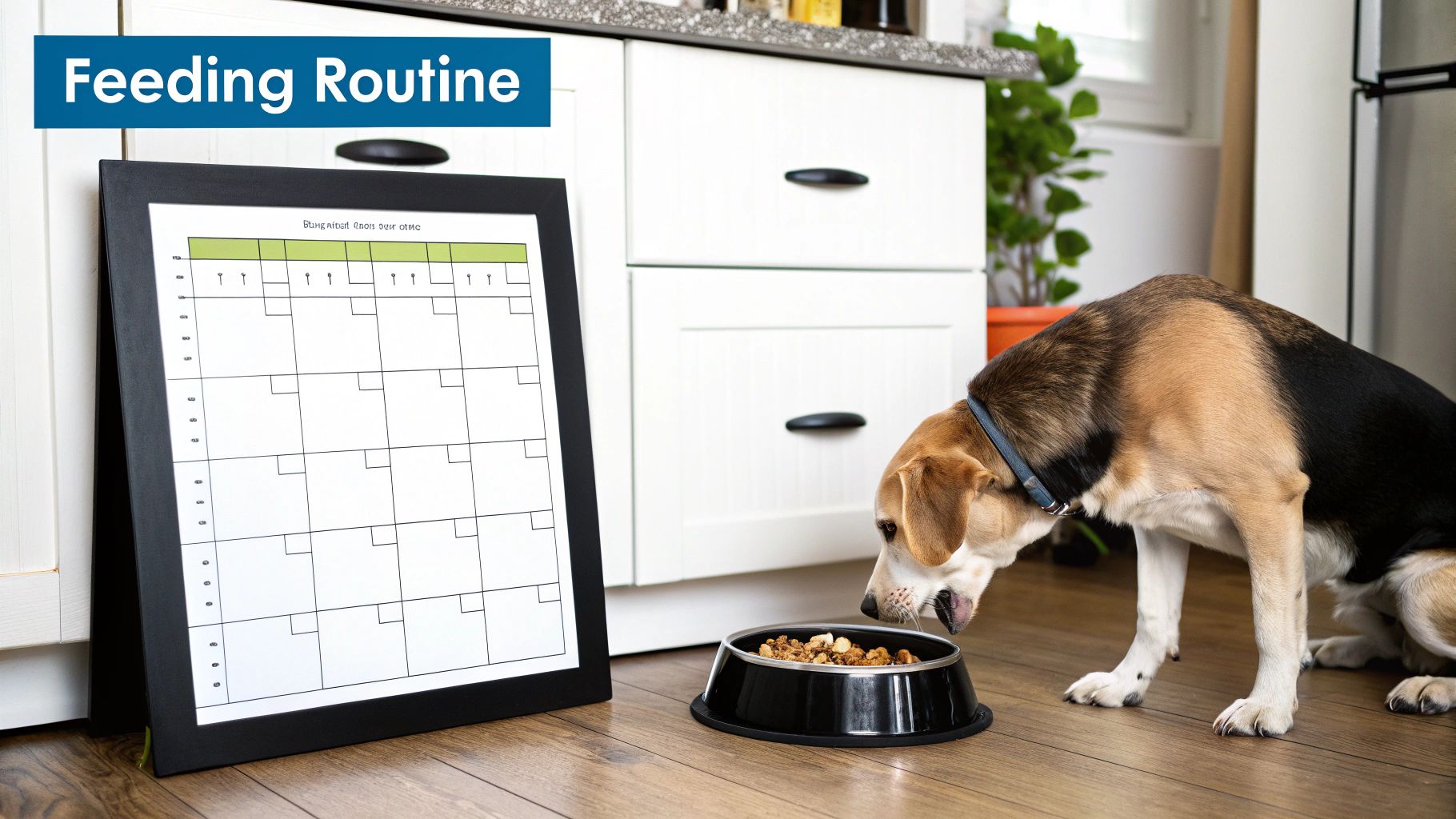
Honestly, the structure you create around meals can be just as important as what’s actually in the bowl. It teaches your dog when to expect food, which helps regulate their appetite and stops them from holding out for something better.
Scheduled Meals vs. Free-Feeding
One of the single most effective changes you can make is ditching the free-feeding habit (leaving a full bowl out all day) and switching to scheduled meals. When food is always available, it just doesn’t seem as valuable. It’s a common reason dogs start ignoring their kibble.
Scheduled meals, on the other hand, build anticipation. Offering food at the same times every day—usually once in the morning and once in the evening—works with your dog’s natural rhythm and creates a reliable routine.
This simple switch pays off in a few ways:
- Builds Appetite: Your dog learns that food is served at specific times, which can make them hungrier and much more interested when the bowl finally hits the floor.
- Monitors Health: It’s way easier to spot a loss of appetite—a major health red flag—when you know exactly how much your dog normally eats at each meal.
- Prevents Overeating: For keeping your dog at a healthy weight, especially for breeds prone to packing on pounds, scheduled feeding is a must.
The 20-Minute Rule
Once you have your mealtime set, the next step is teaching your dog that this is their window to eat. Put their food bowl down and give them about 15 to 20 minutes. If they walk away or haven’t finished, just calmly pick the bowl up.
This isn’t a punishment; it’s just clear communication. You’re teaching your dog, “This is when mealtime happens.” Trust us, they won’t starve by missing a partial meal. They’ll quickly learn that the food isn’t available 24/7, and you’ll probably see a lot more enthusiasm at their next scheduled feeding.
Key Takeaway: By removing the bowl after a set time, you are gently reinforcing the mealtime schedule. This consistency teaches your dog to eat when food is offered, effectively curbing picky habits that develop when they think something better is coming later.
Avoiding Accidental Encouragement
It’s so easy to do. Many well-meaning dog owners accidentally create a picky eater. We’ve all been there—your dog gives you those sad, soulful eyes, and you can’t resist tossing them a little piece of chicken from your dinner plate. The problem is, that one small act teaches a very powerful lesson: “If I hold out, I get the good stuff.”
To build a solid routine, you have to be firm. Stop all table scraps and cut back on high-value treats between meals, especially if your dog is turning their nose up at their kibble. Their main source of nutrition should come from their balanced dog food.
Making ChowPow Part of the Routine
This is where a nutritious topper like ChowPow fits perfectly into your new, structured routine. It isn’t a “table scrap” or an unhealthy treat; it’s a healthy, exciting upgrade to their designated meal.
By sprinkling ChowPow on their kibble at every scheduled mealtime, you create a powerful positive association. Your dog starts to learn that their regular food is now a delicious, aromatic feast they can look forward to. This turns mealtime from a battle into a happy, stress-free event for both of you, making it so much easier to stick with the new routine for good.
Your Questions About Picky Eating Answered
Dealing with a picky eater can leave you scratching your head. You’ve ruled out health issues, you’ve tried all the tricks, but you still have questions. We get it.
Here are the most common questions we hear from dog owners just like you, with clear, straightforward answers to help you feel confident about your dog’s mealtime.
How Long Until My Dog Starts Eating Kibble with ChowPow?
This is the big one, and the answer is usually: right away! For most dogs, the rich, meaty aroma of dehydrated beef heart is enough to get them digging in on the very first try. The smell alone is pretty convincing.
For the more skeptical pups, it might take a couple of meals to get on board. The key here is consistency. If you stick with it, they’ll quickly learn their once-boring kibble is now a delicious highlight of their day.
Can I Use ChowPow with My Dog’s Special Prescription Food?
Yes, absolutely. We designed ChowPow specifically to be a versatile topper that works with any dry food, and that includes special veterinary and prescription diets.
It simply enhances the flavor and smell of the food without messing with its core nutritional job. This makes it the perfect sidekick for your dog’s specific diet, helping them actually eat the food their vet recommended.
Will Adding a Topper Make My Dog Even Pickier?
That’s a fair and common worry. But adding a high-quality, nutritious topper like ChowPow is completely different from giving your dog table scraps. You’re not spoiling them with junk; you’re enriching their meal with healthy, whole-food ingredients.
This approach actually builds a positive association with their kibble. Instead of teaching them to hold out for people food, you’re turning their proper mealtime into an exciting, rewarding, and nutritionally beneficial experience.
You’re not creating a new picky habit—you’re reinforcing the value of their kibble by making their healthy meal the best thing on the menu.
What If My Dog Still Won’t Eat, Even with ChowPow?
While ChowPow works wonders for the vast majority of picky eaters, a dog who flat-out refuses to eat can sometimes be signaling something more. If your dog consistently turns down food for more than 24-48 hours, even with your best efforts, it’s time to loop your veterinarian back in.
A sudden, unshakeable food strike can point to an underlying health issue that needs a professional eye. Your vet can run the necessary tests to make sure there isn’t a deeper problem. Always trust your gut—if something feels wrong, don’t hesitate to seek professional advice.
Ready to transform your dog’s boring kibble into a meal they’ll actually crave? See the difference for yourself and bring joy back to mealtime with ChowPow.

